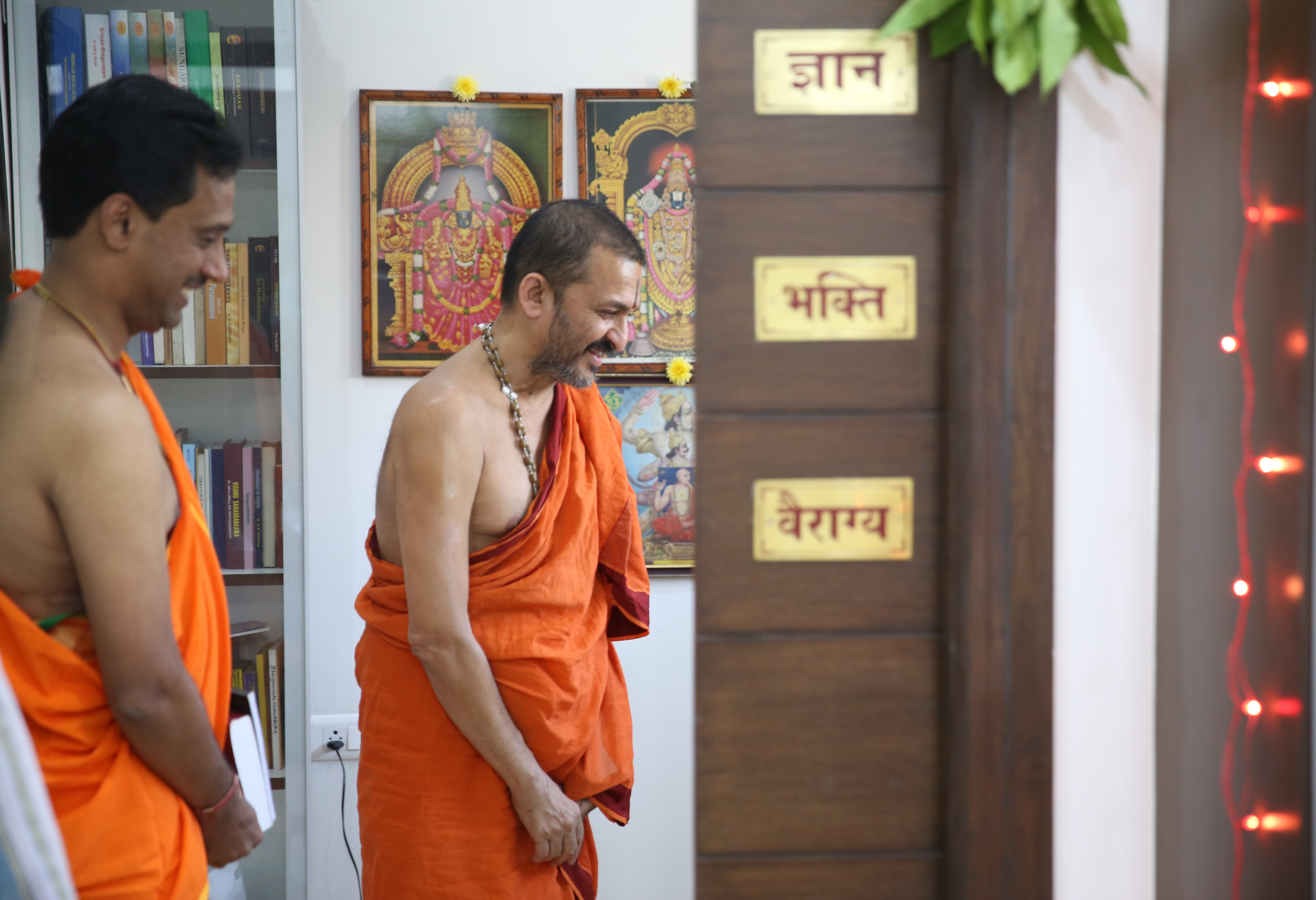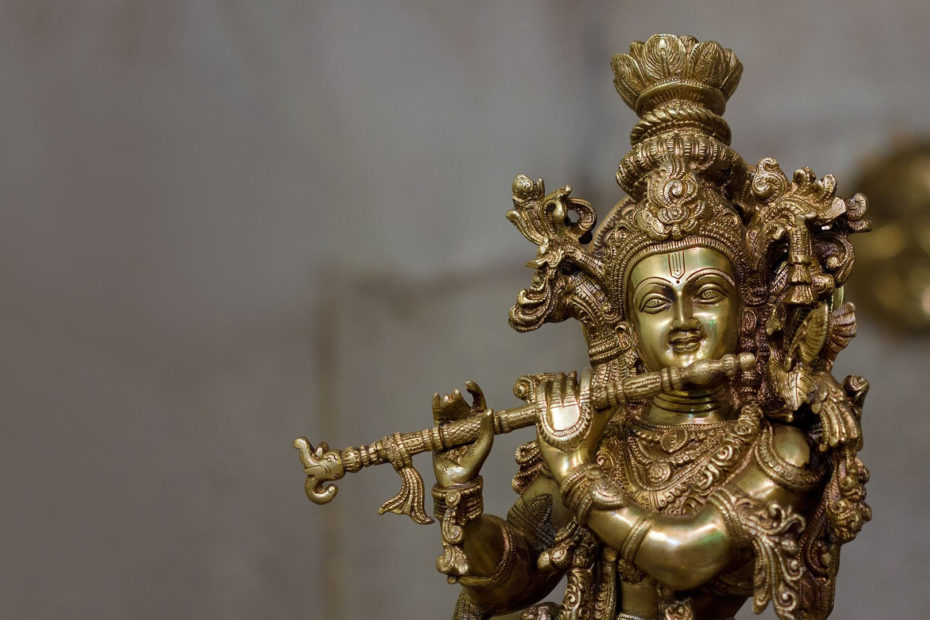Shri Krishna is not a ‘womaniser’
Sri Krishna, the Supreme Lord and epitome of all virtues, will be born in the house of Vasudeva, The divine womnafolk should descend on Earth to serve Sri Krishna, to please Him and to obtain His love.
vAsudeva grihe sAkshAd bhagavaan purusah parah
janishyate tatpriyArtham sambhavanthu sura striyah
For long, an often repeated charge that has racked the minds of the discerning is that Shri Krishna was a thief, was chummy with women, was of an amorous disposition etc. In a way, the above averment of Vedavyasa provides answers to various canards and objections, including those mentioned above.
It is true that the supreme Lord Krishna, during His incarnation, did hold the hands of many ladies. It is also not untrue that during His childhood, He gallivanted with girls. However, that is no reason to cause embarrassment in His devotees. Several people get fidgety about this matter and end up groping for answers. Whenever accosted with such statements, it is but natural for any person to ponder about why, how and what is being stated. It is, therefore, not unnatural that people would ponder over such matters even in the case of Shri Krishna. For fortifying the steadfastness of their devotion to Krishna, it is vital that His devotees have a right and proper understanding of His exploits. Further, this understanding must not be blind, but be buttressed in the edicts of the scriptures. Any failure to do so will jeopardise devotion to Him.
The damsels who were in touch with Krishna during His sojourn on earth were not ordinary women. Each of them was divine and had come down from the higher worlds. They had all descended on the earth. The Bhagawatam itself reveals this truth. This is evident in the above statement of Bhagawatam. sambhavanthu sura striyah. By ignoring this central statement, the society today, plunges itself in confusion on all aspects concerning Lord Krishna. Many vicarious and apparently concealed averments are made in the Bhagawatam. Such averments were uncovered and correctly interpreted by Acharya Madhwa. It was he who brought forth the apt meaning and helped in eliminating the misconceptions that had crept in. When we understand sambAavanthu sura striyah in the background of the techniques of interpretation provided by Acharya Madhwa, clarity emerges on the statement made by Vedavyasa.
Mahalakshmi alone is eligible for a direct contact with Shrikrishna’s body, as He is an incarnation of Bhagawan Narayana. Not any other soul. This is the fact.
At a time when the Kuru clan required progeny for the clan’s continuation, Satyavathi beseeched Vedavyasa to bless the clan with good offspring through her daughters-in-law. Acharya Madhwa documents the averment of Vedavyasa, an incarnation of the Supreme Lord Himself, in this context:
Rthe RamAm JAthu MamAngasangayogAngana naiva surAlayopi (Mahabharata Tatparya Nirnaya)
Save for Rama (Mahalakshmi) none is eligible or worthy of contact with my body There is no such soul even in the abode of gods.
When the fact is this, the question arises as to how the Gopika damsels enjoyed contact with Krishna’s body?
Acharya Madhwa deduces and concludes that it was the presence of the element or charge of Mahalakshmi in each of the damsels which made such proximity possible.
tatra sannihita shreeshcha yatra sannihitho harih
naasya Sannidhimaathrena ramaa patnithvama vrajeth
saakshadevathu saakshacha hareh sannidhitah kvachit
“gopyadi roopabhavati “ vipareetham na tu kvachit
– (Bhagawata Tatparya Nirnaya)
The purport of this is as follows: There is the presence of goddess Lakshmi, undoubtedly, in the body in whose husban the Supreme Lord is present. The mere presence of Hari in a man, does not mean that Mahalakshmi becomes the wife. Only when the Supreme Lord Hari descends in His entirety does Mahalakshmi also descend as such. Be that as it may, in some ladies, She manifests Herself and becomes His wife. Examples include the Gopika women, Jambavathi, etc. Although Mahalakshmi manifests Herself in women to become the wife of Hari when he appears in His entirety, the converse is not true, i.e., when He manifests Himself partially, Mahalakshmi (as in Her entirety) does not become His consort.
Thus, it must be understood that a partial presence of Mahalakshmi was there in the Gopika women and they were not incarnations of Mahalakshmi, much less, did they have Her presence in them in entirety. Further, Acharya Madhwa also brings forth a prayer made to Hari, by the Gopika women when they were celestial beings.
agre dvijatvata upAvahidesha nelAm
Gopangana api purA varamApire yat
SamskAratah prathamameva susangame no
Bhooyat taveti paramApsarasah purA yAh
– (Mahabharata Tatparya Nirnaya 13-50)
The purport of the above prayer of the divine damsels or nymphs is that while ‘you descend on the earth as Krishna, we seek proximity with you even prior to your Upanayanam’.
Therefore, it becomes clear that Krishna did not entice these damsels; rather, the damsels sought His companionship. When one comprehends the logic behind the statements made by Acharya Madhwa, it also gets clarified that Neela Devi, too, performed penance to propitiate Krishna and sought Him.
Next, the question arises about the 16,100 young girls kept captive by Narakasura, each of whose hand too, Krishna had held. Who else, but the Supreme Lord of the universe would protect them?
The rationale and explanation behind this conundrum is demystified by our preceptor, Ananda Teertha Bhagavatpada. Its explanation is as follows – The 16,100 young girls kept captive by Narakasura were actually sons of the Fire god. They engaged themselves in penance and earned boons from Shri Mukhyaprana to become the spouses of Krishna.
Putra agneh purvamAsamscha tetha
SthritvaprAptyai chakruragrayam tapascha
(Mahabharata Tatparya Nirnaya; 20-113)
BhAryArthvarthe vAsudevasya Yoshi
Ttanum tAsamicchatheenAm sameerah
– (Mahabharata Tatparya Nirnaya; 20-114)
Acharya Madhwa substantiates his explanations with a quote from the Mahakaurma (purana)
Agniputra mahAtmanasthapasa sthritvamApire
BhartAram cha jagadyoninam vasudevamajam vibhum
– (Bhagawata Tatparya Nirnaya – 1-10-31)
Each of the six damsels who held the hand of Krishna were intrinsically celestial women. Acharya Madhwa says that all the Gopika women elevated their love to the heights of devotion. In the background of the light shed by Acharya Madhwa on the statements of Vedavyasa, the phrase sambhavanthu surastriyah opens the gate of right understanding. The true purport of Vedavyasa’s statement is that Krishna held their hands to bless the damsels concerned and fulfil their desires, but not for His gratification.

Ever engaged in the sadhana of Srimadvaishnava Siddhanta of our Guru, Acharya Madhwa and all the Yatis and Dasas who have blazed this noble path. May HVG bless us all

Pingback: Shri Krishnayana - 12 - Sarvamoolapatrika